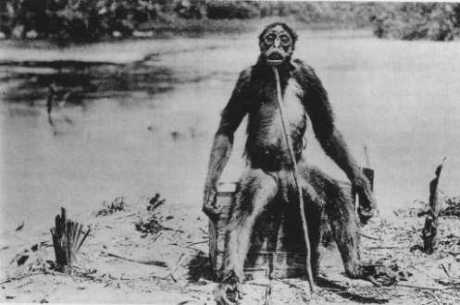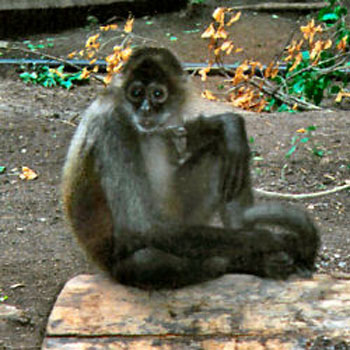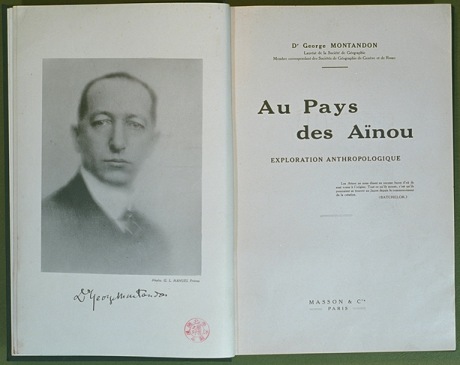
March 29, 2007

If this was such an extraordinary image, why did the alleged photographer not show the back end of the primate and why did he keep it stored away for almost ten years?
The photograph (above) of an alleged “Ameranthropoid ape” supposedly was taken in South America by François de Loys. It has a checkered history, and was used for proto-Nazi racist promotion in the late 1920s and early 1930s, despite the fact it is most certainly a spider monkey (below).


Basically, two schools exist about this photo. 1) There are those that believe the François de Loys story and thus believe he saw some apes run bipedally. They believe he killed one, and he photographed an “ape”; and 2) there are those that understand the evidence appears to demonstrate a hoax coming out of George Montandon’s promotion and François de Loys’s interest in supporting a racist theory for the origins of the Indians of the Americans. All testimony and photographic evidence must be viewed in light of their racist motives, in my opinion. And the “ape” story, mostly supported by verbal information, then collapses easily.
While Heuvelmans, in his classic book, On the Track of Unknown Animals (Fr. 1995; Eng. 1958), writes the de Loys photograph is one of the best pieces of evidence for a cryptid, he appears to have changed his firm stance by the time his checklist was published. He retreated in his opinions on the creature for when the checklist was published in Cryptozoology in 1986, this photographic evidence was not mentioned.
However, Heuvelmans still retained the notion that large unknown apes or large monkeys may exist in South America, a concept that I agree with, of course. Consideration of apes in South America, I contend, has nothing to do with being skeptical of the de Loys photo. It will also be noted, Heuvelmans does not mention the Patterson-Gimlin footage either, as he does not accept that this film from 1967 is authentic.
I would assume that many which rush to note Heuvelmans apparent support of the de Loys “ape” do not so quickly side with his opinion of the Patterson-Gimlin film. On these two issues, I tend to disagree with Heuvelmans’s sense of both, as I accept the Patterson-Gimlin footage as a good probable record of a Bigfoot in California, but found the de Loys “ape” photograph has been employed in such a way that it must be labeled a hoax.
Michel Raynal and I wrote extensively about the de Loys matter in two issues of The Anomalist; one was the article noted directly below, and the other was a followup rebuttal to critics.
————-
The Anomalist 4
Autumn 1996
“De Loys’s Photograph: A Short Tale of Apes in Green Hell, Spider Monkeys, and Ameranthropoides loysi as Tools of Racism”
by Loren Coleman and Michel Raynal
Perhaps the most famous photograph in cryptozoology is the snapshot of an animal, said to be an ape, seated on a wooden crate, taken in the rainforests of South America, allegedly in 1920. Adventurers, popular anthropologists and early cryptozoologists have retold the story of this South American ape photograph so many times, that it has become one of the field’s most celebrated illustrations . . . It is time to ask why the animal in the photo was promoted as an “ape”–instead of just being viewed as a curious picture of a large spider monkey. The answer lies in racism…84.
>
———
On this subject, I agree with Ivan T. Sanderson when he writes:
This matter has played such a prominent and, in my opinion, harmful and misleading part in ABSMery, I would like to try and dispose of it once and for all – or, at least, once again; for this has really been done several times already…
First, this picture produced by Dr. Francois de Loys is obviously that of a Spider-Monkey which is a very distinct type of South American primate that may be seen in any zoo. It displays all the characteristics of that genus – narrow shoulders and pinched chest; comparative lengths of upper and lower arms and legs; hands and feet in detail; and the enlarged clitoris of a female. In fact, it is a pretty clear picture of one of these animals – dead.
Sanderson’s book can be read for his insights into how to determine the height of this not too tall spider monkey. Raynal’s analysis concurs. Then Sanderson goes on:
Thus this animal, with its head poked up to an unnatural degree by a stick, measures about 27 inches [it measuring 10x:6x as against the box]. This is a fair-sized Spider-Monkey but not even a large one.
The original photograph is not just a case of mistaken identity; it is an outright hoax, and an obnoxious one at that, being a deliberate deception….Ivan T. Sanderson Chapter 8, Abominable Snowmen: Legend Come to Life, Philadephia: Chilton, 1961.
As Sir Arthur Keith said about this picture when he saw it: “A photograph of the animal from behind would have clinched matters…”

The French cryptozoologist Michel Raynal must be fully credited with the rediscovery that the describer of the alleged new species, Dr. George Montandon, was actually a racist and anti-semetic, who thought that “Whites” derived from Cro-Magnon man, “Blacks” from gorillas, and “Orientals” from orangs and gibbons. His hatred of Jewish people was graphically shown during the 1930s-1940s when he tried to devise ways to stop the Jewish population from reproducing (one “solution” of his was to cut off the noses of Jewish women). The de Loys “ape” was the final piece in the Montandon-de Loys racist theory that this new Ameranthropoid was the ancestor of the American Indians (or in one version, “the Jews”).
The entire discussion of this photograph needs to be framed in terms the François de Loys “ape” being a spider monkey and it’s use as that of a hoax for political purposes.
People have assumed details told by de Loys as fact, such as the report of the attack of the two primates, the number of teeth found, and other details. But how does one count 32 teeth (a detail first noted by Montandon) in the photo, as the skull was reportedly lost? Any statements of François de Loys and George Montandon are suspect.
Raynal also found new information (from material published first in 1929 and 1962) that confirmed what we had earlier discovered. Raynal found that François de Loys
– tied his “discovery” to the origins of Indians theory from the beginning,
– modeled the encounter on the gorilla-hoax encounters from Africa.
And from an acquaintance of de Loys, records reviewed by Raynal indicate that
– de Loys was a “bromista” (prankster);
– the tail of the monkey was probably cut off by de Loys; and
– the animal was photographed in a banana plantation.
Most likely, the animal in the photo was simply an upper-limit-sized female specimen of Ateles belzebuth, a spider monkey. Thus, no South American ape has ever been photographed. White-bellied or long-haired spider monkeys, Ateles belzebuth, are found in the northeastern portion of the Amazon in South America. Colombia, Venezuela, Peru, Ecuador, and Brazil.
The expedition of de Loys was reported to be in Venezuela. The explorers took some photos, and returned to put them in with de Loys’s pile of other photos, unremarkable travel images, for nine years, until a proto-Nazi discovered them to use for his own sinister purposes. Unfortunately, some people interested in cryptozoology still champion them without taking any account of their history.
In 1998, Pierre Centlivres and Isabelle Girod published an article on the améranthropoïde, in the review of Gradhiva ethnology, and come to the radical conclusion: it is about a hoax assembled by George Montandon, on the basis of its prejudice (racialism) on the origins of the man. Having fallen by chance on the photograph from the monkey by traversing the documents piled up by Loys on the Motilones Indians, Montandon saw there the “missing link” between the South American monkeys and the Indians, who consolidated it in his delirious theory of the ologenism. Consequently, he used it to prove the existence of a South American anthropoïde (Centlivres and Girod 1998).
It is the assumption already discovered (independently of Centlivre and Girod), by Loren Coleman and Michel Raynal (1996, 1997), two researchers whom one can only with difficulty suspect of being anti-cryptozoologique.Michel Raynal
References:
CENLIVRES, Pierre, and Isabelle GIROD
1998 George Montandon and the large American monkey. The invention of Ameranthropoides loysi. Gradhiva, n° 24: 33-43.
COLEMAN, Loren, and Michel RAYNAL
1996 De Loys’ photograph: shorts have bruises of apes in Green Hell, spider monkeys, and Ameranthropoides loysi have the tools of racism. The Anomalist, n° 4: 84-93 (Autumn).
1997 One of Loys’ S photograph. The Anomalist, n° 5: 143-153 (Summer).
MONTANDON, George
1929 Discovered of a monkey of appearance anthropoïde in South America. Newspaper of the Company of the Americanists of Paris, 21 [n° 6]: 183-195.
OLIVIERI, Guido
1999 the mysterious monkey of Of Vaud of Loys. 24 Hours (October 15).
VILORIA, Angel L., Free URBANI, y Bernardo URBANI
1998 François de Loys (1892-1935) there a hallazgo desdeñado: the historia of una controversia antropológica. Interciencia, 23 [n° 2]: 94-100 (marzo-abril).
VILORIA, Angel L., Free URBANI, Stuart McCOOK and Bernardo URBANI
1999 Of Lausanne to the forests vénézuéliennes. Geological mission of François de Loys (1892-1935) and origins of an anthropological controversy. Bulletin of the Company Of Vaud of the Natural Science, 86 [n° 3]: 157-174 (September).
About Loren Coleman
Loren Coleman is one of the world’s leading cryptozoologists, some say “the” leading living cryptozoologist. Certainly, he is acknowledged as the current living American researcher and writer who has most popularized cryptozoology in the late 20th and early 21st centuries.
Starting his fieldwork and investigations in 1960, after traveling and trekking extensively in pursuit of cryptozoological mysteries, Coleman began writing to share his experiences in 1969. An honorary member of Ivan T. Sanderson’s Society for the Investigation of the Unexplained in the 1970s, Coleman has been bestowed with similar honorary memberships of the North Idaho College Cryptozoology Club in 1983, and in subsequent years, that of the British Columbia Scientific Cryptozoology Club, CryptoSafari International, and other international organizations. He was also a Life Member and Benefactor of the International Society of Cryptozoology (now-defunct).
Loren Coleman’s daily blog, as a member of the Cryptomundo Team, served as an ongoing avenue of communication for the ever-growing body of cryptozoo news from 2005 through 2013. He returned as an infrequent contributor beginning Halloween week of 2015.
Coleman is the founder in 2003, and current director of the International Cryptozoology Museum in Portland, Maine.
Filed under Artifacts, Breaking News, Conspiracies, Cryptotourism, CryptoZoo News, Cryptozoologists, Cryptozoology, Expedition Reports, Hoaxes, Out of Place, Pop Culture